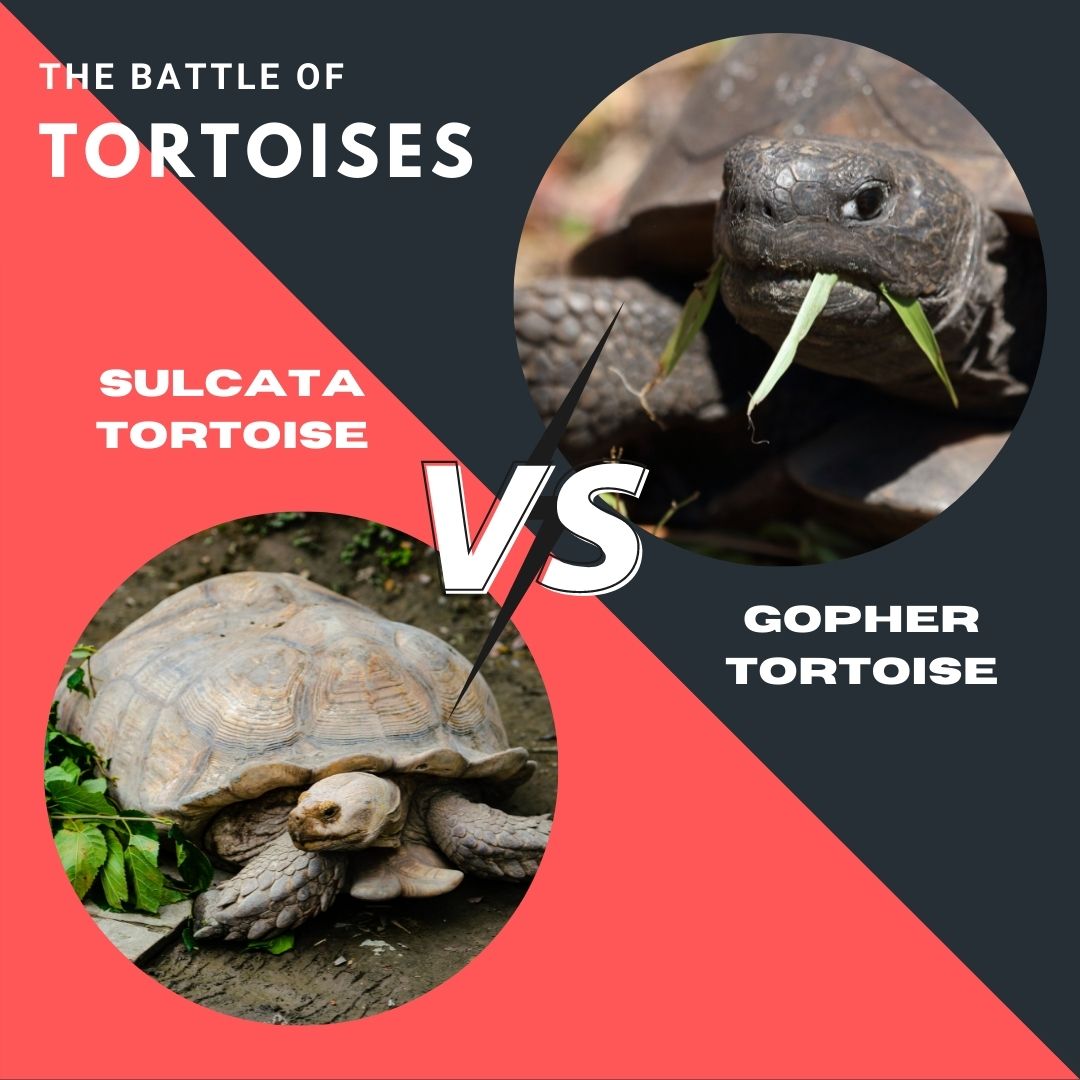It’s an undeniable fact that you love tortoises and would want to have one as a pet. I bet you would have a change of mind about gopher tortoises after reading this article.
Both sulcata and gopher tortoises will make you great pets but should you keep them as one?
This article draws a comparison on both species of tortoises and seeks to address the similarities, differences, and why you should or should not want to confine one in an enclosure as a pet.
In the end, you should be able to make a good choice of which species of tortoise to go for.
Keep reading!
Contents
Sulcata vs Gopher Tortoise As Pets
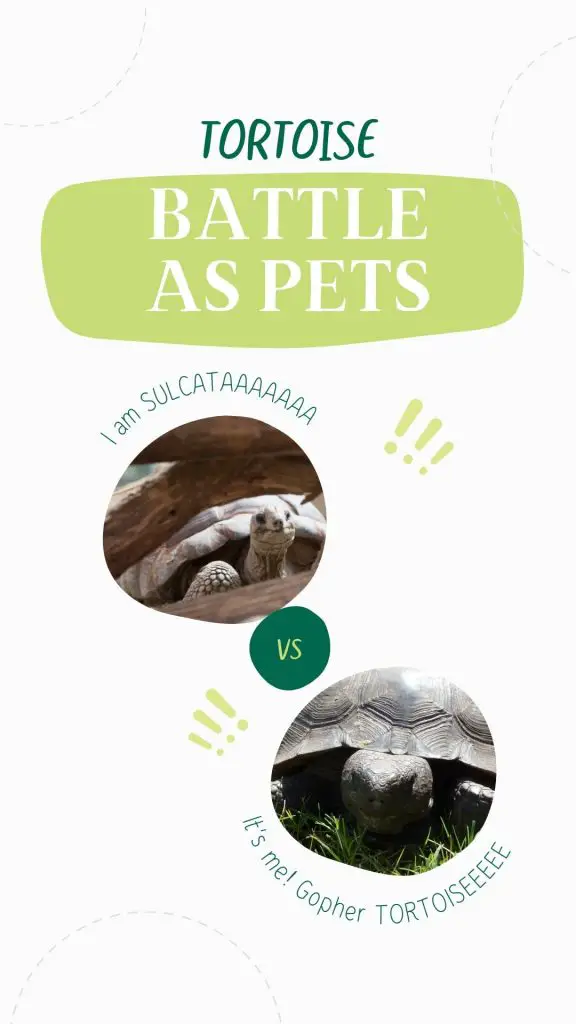
It’s not an ideal thing to confine gopher tortoises in homes as pets. Although there’s nothing wrong to keep a gopher tortoise as a pet, this species of tortoises is one of the most protected animals in the wild.
They are highly protected and preserved by law because of the useful economic role they play in the ecosystem. Studies have proved that the extinction of gopher tortoises in the wild is likely to put the lives of a large variety of other species of animals in danger.
This is because these other species of wild animals depend largely on gopher tortoises’ burrows in times of danger. For this reason, they are called the keystone animals.
Their name ‘gopher’ comes from the rodent gopher which is known to dig magnificent burrows for shelter.
Thus, gopher tortoises are associated with the ability to dig big tunnels of about 50ft deep and 17 meters wide that are capable of accommodating over 350 other species of animals including snakes.
It is in these tunnels that they and other animals take shelter from the scorching heat of the sun, bush fire, other natural disasters, or even predators. Hence, keeping them as pets will create an imbalance in the ecosystem.
Besides, going by the strict laws and restrictions against keeping gopher tortoises as pets, if you still want to keep one, you’ll need to get permission and a license from your government to have one.
Oftentimes, your home will be inspected to ensure that you have a big open field where the tortoise can dig as though in the wild.
On the contrary, sulcata tortoises aren’t listed as endangered neither are there strict laws regulating their ownership as pets. Despite their large size of about 30 inches, you can still own them as pets.
They are docile and friendly animals that’ll get easily acclimatized to their domestic environment. The only thing you should be concerned about is having enough outside space to construct them an outdoor enclosure once the animals get to adult size.
Sulcata vs Gopher Tortoise: Full Comparison
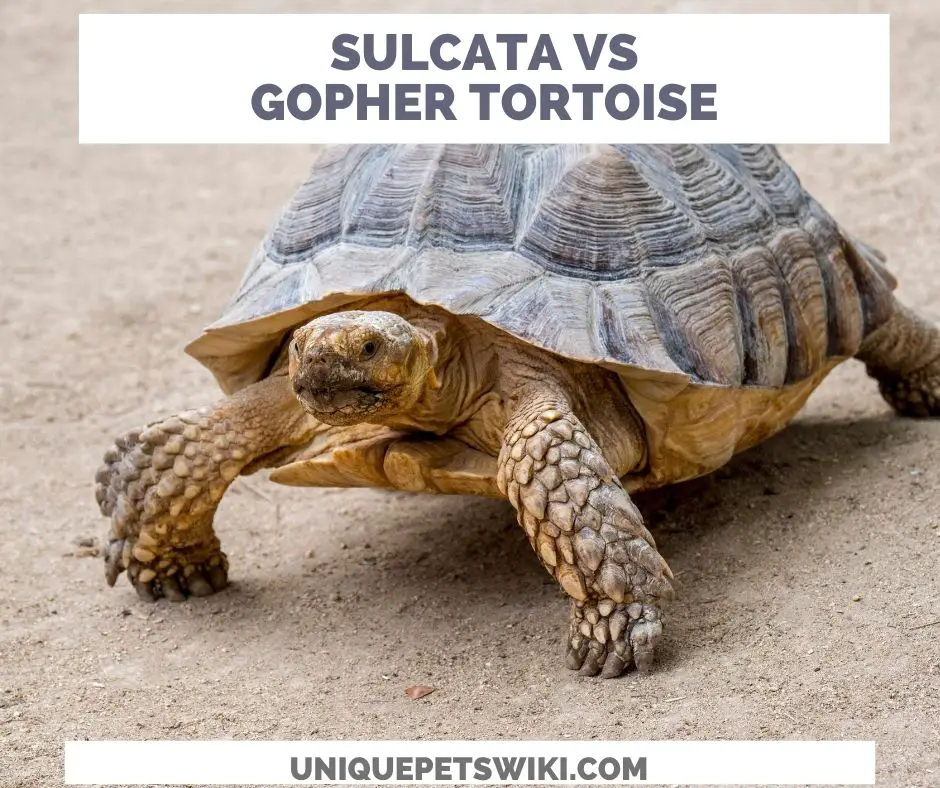
Considering the effect of domesticating gopher tortoises on the lives of other wild animals whose safety is solely dependent on them, you may want to go for a sulcata tortoise instead.
Besides, from our discussion in the previous sections, since gopher tortoises are listed as endangered and protected under the law, private ownership of these animals has become difficult if not impossible.
That notwithstanding, you can still go through the stress of getting a license to keep one if you so desire it. That said, what should you expect from having any of these species as a pet? Let’s explore that in this section.
Lifespan
Gopher tortoises are precautious animals. Other than natural disasters such as a sudden bushfire when they aren’t anywhere near their tunnels or deforestation, they would live for as long as 90 years or above.
However, their average lifespan in the wild is between 40 – 70 years. In captivity, they can live for as long as 86 years and above with good care. On average, they live for 60 years in captivity.
Sulcata tortoises on the other hand live longer than gopher tortoises both in the wild and captivity. Both in the wild and captivity, they have a lifespan of 105 years.
Habitat
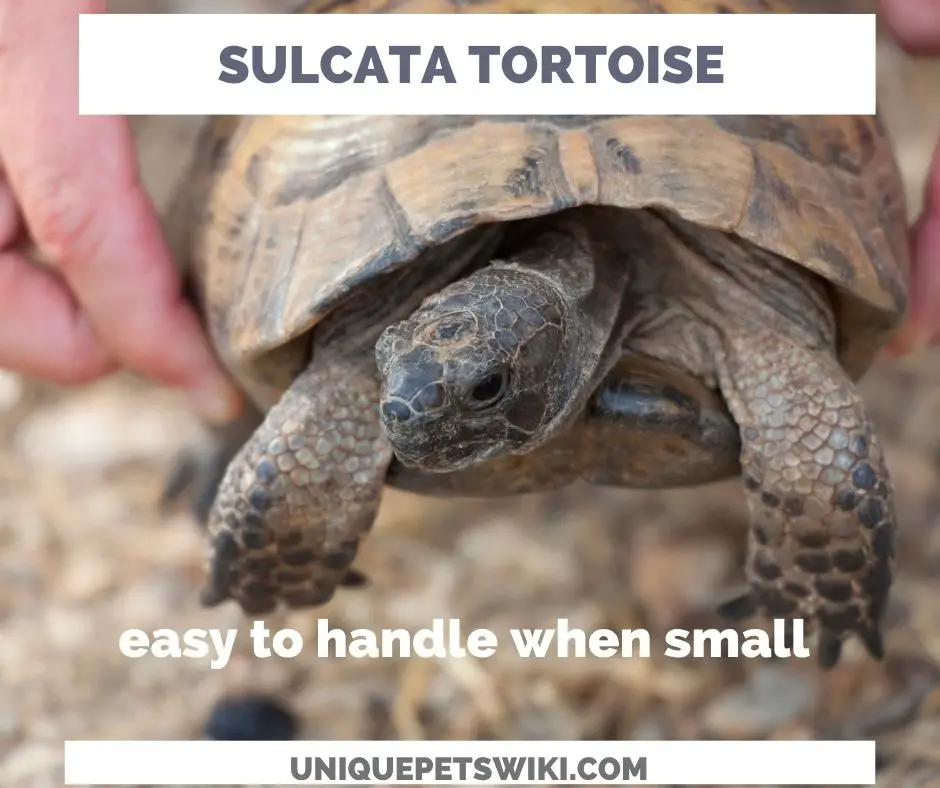
Both sulcata and gopher tortoises are terrestrial animals. But while sulcata tortoises are found in Southern Sahara deserts in Africa, gopher tortoises are native to the Southeastern United States.
In the regions where gopher tortoises are mostly found, they inhabit dry, sandy soils with low-growing vegetation. The availability of sandy soils in their habitat is one of the reasons gopher tortoises can dig tunnels as deep as 50ft capable of housing other animals.
On the other hand, sulcata tortoises inhabit the hot, dry, and rocky deserts of the Sahara deserts. In these regions, they have access to very little or no water throughout the year.
Thus, their primary source of water is from the fibrous plants they eat. For this reason, their habitat in captivity must simulate this hot desert environment.
What this means is that their cage temperature must be maintained within the normal range with a low humidity level.
That said, you’ll need the following to set up a habitat for your pet sulcata tortoise.
- A Sizeable Enclosure: Depending on what you want to provide for your pet tortoise, the ideal size for an indoor enclosure for an adult sulcata tortoise is about 80ft with strong walls.
However, the best way to keep adult sulcata tortoises is to construct them outdoor enclosures. This will guarantee them a bigger and stronger cage with lots of floor space to roam.
- Plants and some rocks.
- Substrates: Going by where they come from, the ideal substrate for captive sulcata tortoises is a mixture of different types of substrates. This is because their natural habitat comprises dry and rocky soils.
Note that whatever you choose as its substrates must not be loose-particles to avoid impaction. More information on ideal habitat setup here.
Size
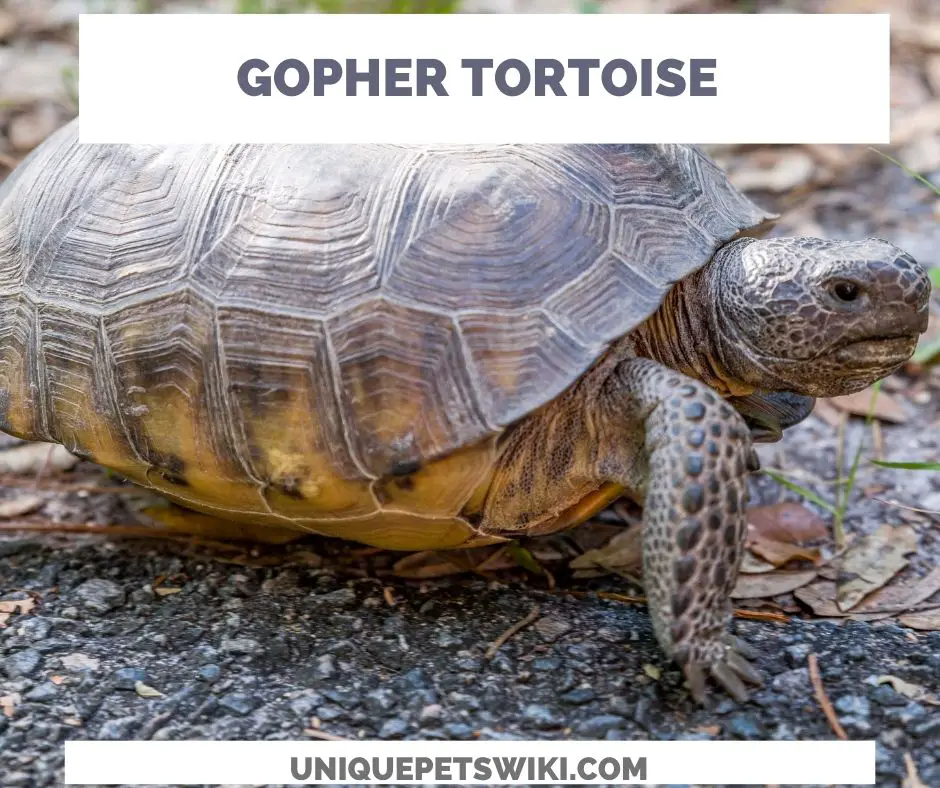
In terms of size, gopher tortoises would make a lovely pet because even as adults they’re still manageable in size.
Whereas, sulcata tortoises are often a burden to some keepers when they get to a certain size that cannot be housed indoors again.
On average, gopher tortoises measure about 25.4cm and weigh 12.15 pounds. The biggest gopher tortoise would get is 38.7cm.
On the flip side, at the age of two, your sulcata tortoise will need an outdoor enclosure. They usually measure about 30 inches and weigh over 100 pounds as adults.
Weight
As mentioned earlier, gopher tortoises weigh about 12 pounds on average as adults. That’s a good weight and can be handled even as adults.
But sulcata tortoises are often referred to as ‘living bulldozers’ because they usually weigh much heavier and are capable of moving heavy household equipment such as furniture if kept indoors. They weigh over 100 pounds in the space of 15 years.
Looks
All tortoises no matter the species have three things in common. That is a domed shell, rough skin, and thick stubby legs that facilitate movements despite their heavy shell.
However, within these similarities lie some distinctive differences that are only unique to each species. These unique differences are why they can do certain things in particular ways different from the other species.
Gopher tortoises, for instance, have flattened, unwebbed, stump-like, and shovel-like feet. All these features in their feet help them in digging huge burrows as deep as 50ft and 17 meters wide that they can take refuge during disaster.
While you would think that sulcata tortoises are good diggers, gopher tortoises will amaze you.
Sulcata tortoises are brown in color with a golden-brown or tan skin color. They have a broad and oval-shaped carapace that is slightly more convex than that of gopher tortoises.
On the flip side, gopher tortoises’ carapace are oblong in shape. Their shell color ranges from tan or brown to gray. The shell dimensions of female gopher tortoises appear larger than the males with a relatively flatter plastron than the males.
Active Levels
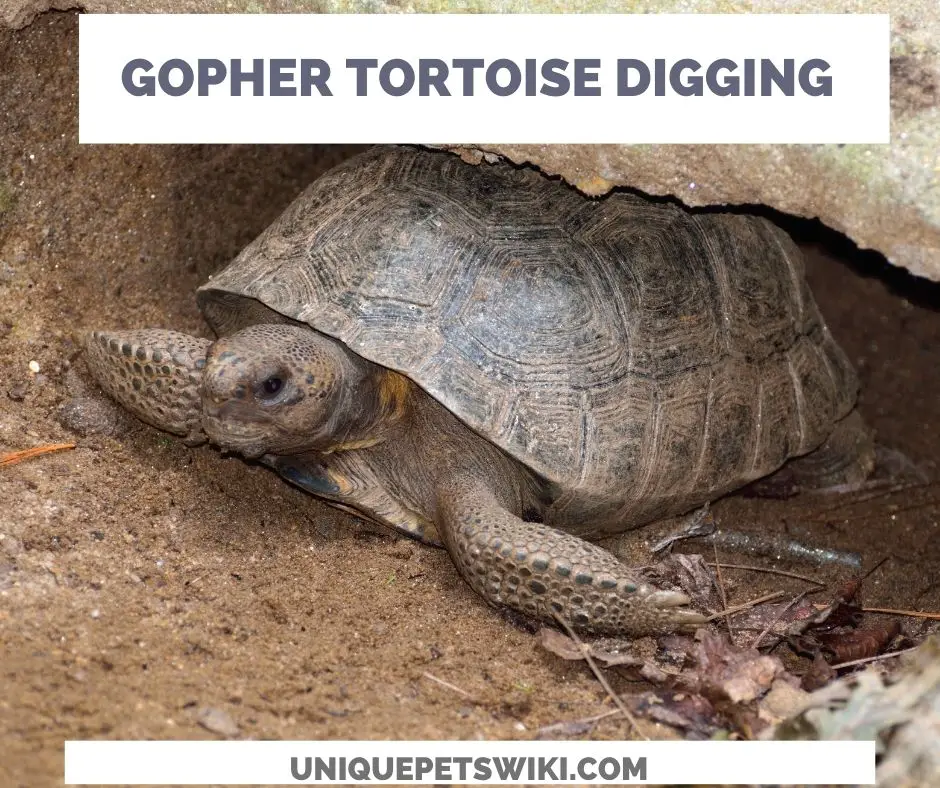
Despite their different habitat, both sulcata and gopher tortoises are diurnal animals. This means that in their wild environment they’re most active during the day and they enjoy basking in the sun.
Especially in the morning and late afternoon and when the temperature is within what their body can tolerate since they are ectothermic.
Since they depend heavily on their environment (the sun) to carry out every activity, they’ll dig burrows that can accommodate them when temperatures are insufficient for normal activities.
Gopher tortoises in particular are active all through the year. But their most active levels are recorded between April to June and September to October. During winter when the temperature is below 21 C, they appear dormant to conserve energy.
Sulcata tortoises on the other hand are seen to be active when the temperature is within the 77 F – 95 F range. This is also their ideal temperature both in the wild and captivity.
In a nutshell, if you have any of these species of tortoises around as a pet, be assured that you’re keeping a pet that’ll be active throughout the year and is likely to dig around your house. This is why it’s better to keep them outdoors than indoors.
Diet
Sulcata and gopher tortoises are both herbivores. They diet primarily on a wide variety of grasses and leaves.
Gopher tortoises for instance are known to feed on 400 different species of herbaceous and low-growing plants. These include prickly pear cactus, wiregrass, legumes, blackberries, and many more.
In the wild, gopher tortoises would occasionally eat plant leaves, fruits, flowers, stems, and shoots. They do not eat insects except for nesting females who were found eating fungi, carrion, insects, bone, and lichens.
This can be explained by the fact that during and after nesting when they do not move around frequently, they would only eat what crosses their path since they can’t go foraging.
Sulcata tortoises on the flip side, feed majorly on green grasses and leaves that are rich in fiber but low in protein. For both species of tortoises, the water they need is gotten from their diet although they will drink when they see water.
Brumation
Brumation for tortoises is based on species. Many species do not brumate and a few others that can brumate.
Sulcata and gopher tortoises are two species of tortoises amongst others that do not brumate in the wild and for no reason should they brumate in captivity. These animals may die if triggered or forced into brumation.
In the wild during winter, they usually become inactive and dormant to conserve energy throughout the cold period. What this means is that they usually will not eat since they can’t digest their food in low temperatures. This doesn’t mean brumation as some keepers would assume.
However, in captivity, if your temperature is constantly low, it’ll trigger them to stop eating and become inactive. When this happens, if the low temperature continues for a long time, it may lead to serious problems or even death.
Burrowing for these species of tortoises isn’t for brumation. Both species, especially gopher tortoises can stay in their burrow for up to 80% of their time and this does not mean they brumate.
Personality
Gopher tortoises have a great personality that makes them so endeared. Aside from being docile, they play important roles in the ecosystem.
Gopher tortoises are called keystone species because their activities of burrow digging are why some wild species haven’t gone extinct.
They’re symbiotic in nature. This simply means that they can live together with other species of animals that are symbiotic as well. This explains why their burrows serve as consistent protective homes to over 350 species of wild animals.
According to the Florida Fish and Wildlife Conservation Commission, in 2012 when there was a decline in the population of gopher tortoises in the wild, there was a corresponding decline in the population of eastern indigo snakes.
This great personality and importance to their communities is why they are protected from going extinct.
Sulcata tortoises are docile as well. However, they tend to show a bit of aggression, especially from the males. Also, gravid and nesting female sulcatas are prone to aggression. But they will turn back normal once they’re done nesting.
Required Enclosure Size
As earlier stated, it is illegal to confine a gopher tortoise in your home as a pet unless you’re licensed to.
However, even if you’re permitted to keep one, the best way to keep it is in an open field where the tortoise can have space to roam, forage, and dig. This is usually in 1 – 5 acres of land. Males would typically need more space than females.
But for sulcata tortoises, you don’t need a license to keep them. Hatchlings and juveniles can be housed in an 18 x 18 x 12 enclosure. But once they get bigger at two years or more, an outdoor enclosure of 80ft or bigger should be constructed for them.
This will ensure that your sulcata has enough space to itself and this way you can prevent it from destroying any valuable property inside.
Lighting, Heating, Humidity Requirements
Gopher tortoises aren’t commonly kept as pets. Hence, the ideal captive temperature for these species isn’t explicit. But since they aren’t from hot deserts like sulcatas, they cannot tolerate temperatures above 89.6⁰ F.
As mentioned earlier, gopher tortoises can stay in their burrows for up to 80% of their time. They usually stay that long in the burrow to either conceal themselves from the heat of the sun or to stay warm from extreme cold.
In the wild, the temperature at the deepest part of their burrow measures 77⁰ F to 87.8⁰ F.
Sulcata tortoises on the other end are from hot, arid deserts. In captivity, their most active level is recorded within the 77⁰ F– 95⁰ F temperature range.
A basking spot temperature of not higher than 122⁰ F is what they get used to in the wild and that should be replicated in captivity. At night, the temperature should not fall below 63⁰ F.
Cost
Buying and keeping a gopher tortoise may cost you some time and money. You may end up paying through your nose to get the authorities to inspect your home to standard.
As you know you can’t keep these animals indoors. The reason is that besides being good diggers, they are fast-moving animals that love roaming. You’ll need to provide them at least 1 acre of land to roam.
However, as it is illegal to keep them without a license, the same is true of selling them without a license.
Whereas, sulcata tortoises wouldn’t cost you much to buy and maintain it. Depending on the size, sulcata tortoises cost between 50 USD to 1000 USD.
To construct its standard-sized enclosure for the first time will cost you about 300 USD. All put together, buying, feeding, and maintaining will amount to 1500 USD to 2000 USD.
Ability To Keep In Groups
By virtue of their symbiotic nature, gopher tortoises can comfortably stay with other species of animals including tortoises. But the same thing cannot be said about sulcata tortoises.
Sulcatas because of their huge size and slight tendency of aggression should be housed separately. Hatchlings and juveniles that are still small can be housed in the same enclosure.
But once they become adults, separate enclosures should be provided. Nonetheless, if you intend to house them together ensure you construct a larger enclosure with much floor space.
Suitability For Beginners
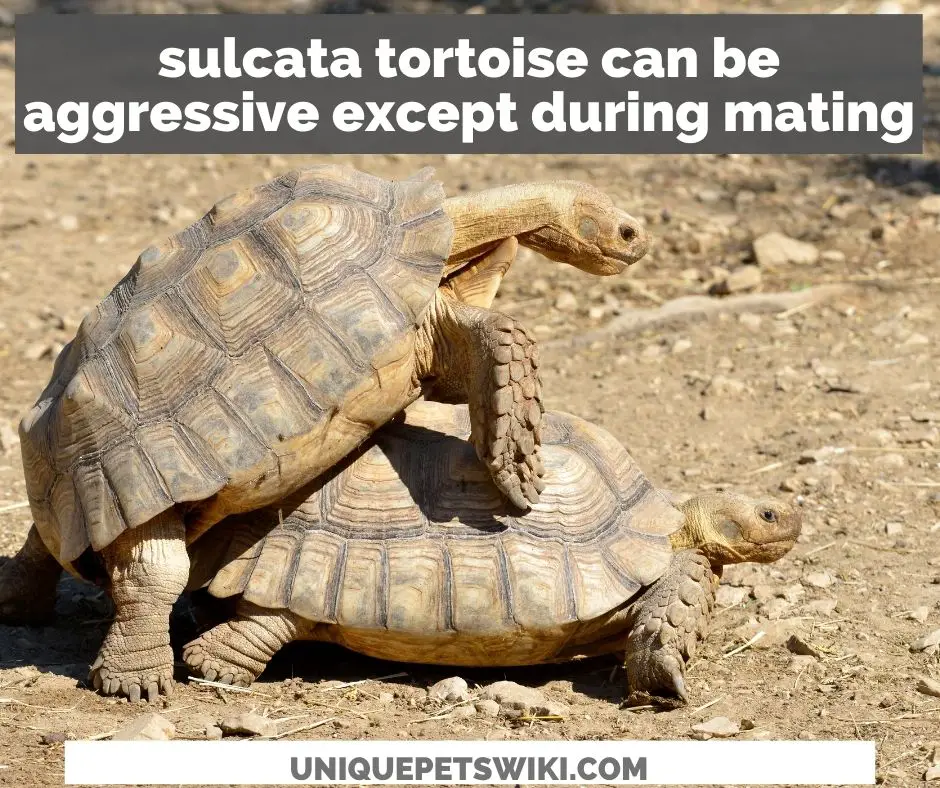
Do sulcata tortoises make great pets for beginners? Yes, they do in all aspects.
Do gopher tortoises make great pets for beginners? The fact that gopher tortoises are protected species can’t be overstated.
Ideally, if you come across a gopher tortoise in your yard by chance, you’re to report to the authorities immediately. The implication of being caught having custody of a protected wild species can be grievous. You can be jailed for it.
In a nutshell, if this is your first time to own a pet or a tortoise as a pet, then I’ll advise you to go for another species but not gopher tortoises.
Can You Keep Sulcata And Gopher Tortoise Together?
Yes, you can keep both species of tortoises together. That is only if you’re licensed to own a gopher tortoise in your yard. But going by the habitat of gopher tortoises, you may not need to put them in the same enclosure with your sulcata.
While your sulcata will do well in a big cage and at a specific temperature, your gopher will need its massive land to roam and dig.
Another thing to be concerned about keeping them confined together is the tendency of your sulcata to show aggression to the other species.
To avoid this, if you’re permitted to own a gopher tortoise alongside other species of tortoises, maintain them separately.
Wrapping Up
At the start of this article, I did ask if you should keep a gopher tortoises as a pet. They have great personalities that’ll endear any reptile enthusiast to them. They’re docile, economically useful to their ecosystem, moderate in size, and very active.
But from what we have discussed in this article, you can’t have them confined in an enclosure as you can with other species such as sulcata, Russian, or Aldabra giant tortoises.
Hence, besides drawing a comparison between the two species of tortoises, this article aims at educating you on the status of gopher tortoises.
That said, since you can’t have gopher tortoises as pets, you may want to choose from other species. But before you do that, how well do you know other species of tortoises?
To make the best choice of pet, Read Our Articles About Other Species Of Tortoises Here.
